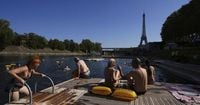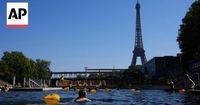Paris, a city long celebrated for its historic bridges and riverside promenades, is experiencing a transformation that few could have predicted: the Seine River is once again open for swimming. After more than a century of prohibition, Parisians and visitors alike are flocking to three newly inaugurated public bathing sites along the iconic waterway, eager to cool off as a summer heatwave sends temperatures soaring to 38 degrees Celsius (100 Fahrenheit).
It’s a scene that would have seemed unimaginable just a few years ago. For decades, the Seine was off-limits for swimmers—deemed too polluted and too dangerous, with bans in place since 1923. But as of July 5, 2025, the river has been officially accessible for public dips, an achievement made possible by a monumental €1.4 billion ($1.6 billion) cleanup operation completed in 2024. According to The Associated Press and The Independent, this environmental overhaul not only restored the river’s health but also paved the way for Olympic competitions to be held in its waters last year.
The Grenelle bathing site in western Paris has quickly become the crown jewel of this new initiative. Swimmers there are treated to sweeping views of the Eiffel Tower, while small fish dart beneath the surface—a rare and picturesque urban tableau. "Imagine that," said Constanze Martens, a tourist from Mexico, to The Associated Press. "Swimming with view of the Eiffel Tower and in pure natural water, clean, safe, and with all this lovely people too, you have every age here."
On Monday, August 11, 2025, the Seine’s water temperature was a balmy 22 degrees Celsius (71 Fahrenheit). For many, the warmth of the river has been a surprise. “It’s quite warm, warmer than the sea, which was quite surprising, and is very pleasant,” Elisabeth Lorin, a Parisian from the suburb of Montreuil, told The Independent. As the city braces for even hotter days, the appeal of a riverside swim has never been greater.
Access to the bathing sites is free until the end of August 2025, with scheduled hours posted on the Paris city hall website (available in English). Depending on the location, anyone aged 10 or older—or 14 or older—can enter. Safety is a top concern: each swimmer must wear a yellow buoy attached to their waist, a precaution that lifeguards say is essential given the river’s strong current and murky waters. “You can only see people’s heads sticking out. That’s why buoys are useful,” explained Marina Gicquel, a 22-year-old lifeguard at Grenelle, to The Independent. “And it’s also quite deep. It’s three to five meters (10 to 16 feet) deep, so people find no foothold.”
The Grenelle site alone welcomes between 800 and 1,200 visitors daily, with a strict limit of 200 swimmers at any one time, according to site manager Yann Forêt. Changing rooms with lockers are provided, and several lifeguards patrol the waters, whistles at the ready to remind swimmers not to jump or leave the designated perimeter. So far, no major incidents have been reported, Paris Deputy Mayor Pierre Rabadan told The Associated Press, a testament to the careful planning and vigilant oversight in place.
Since the opening of the sites on July 5, over 40,000 people have taken the plunge, Rabadan confirmed last week. This impressive figure comes despite almost two weeks of closures, largely due to rainy weather. Heavy rains can overwhelm the city’s pipes, causing untreated wastewater to flow into the river and leading to unsafe levels of bacteria such as E. coli. The risk is not trivial: in 2024, some Olympic competitions had to be postponed for precisely this reason, as reported by both The Associated Press and The Independent.
“Right now, the water quality is excellent and we have optimal conditions with warm weather,” Rabadan said on Monday. Water quality is tested daily to ensure compliance with strict European regulations. The decision to open or close the sites is made each morning, based on a range of factors including recent weather, water flow rates, and any signs of pollution upstream. It’s a delicate balance, but one that city officials say is essential to maintaining both safety and public confidence.
Not everyone was immediately convinced. Some potential swimmers, like Australian Thurkka Jeyakumar, admitted to initial skepticism about the river’s cleanliness. “For the moment, I have to say that it was much nicer and cleaner than I thought it would be,” she told The Independent after finally giving it a try (having lost a bet, no less). “So the bet worked out for the better!”
The return of swimming to the Seine marks a significant cultural shift for Paris. For locals, it’s a chance to reclaim a part of their city’s heritage; for tourists, it’s a novel way to experience the capital’s most famous river. The city’s investment in environmental restoration is paying off in more ways than one, offering relief from the heat, a boost to urban biodiversity, and a powerful symbol of renewal.
Of course, the experiment is not without its challenges. The threat of pollution remains ever-present, especially during periods of heavy rain. City officials have been candid about the need for constant vigilance and ongoing maintenance to ensure the river remains safe for swimmers. But for now, with lifeguards on duty, daily water tests, and enthusiastic crowds, the mood is one of celebration and cautious optimism.
As Paris endures a heatwave and thousands seek respite in the Seine’s cool embrace, the city’s bold bet on environmental cleanup and public health is being put to the test—and, by most accounts, passing with flying colors. For the first time in generations, the Seine is not just a backdrop to Parisian life, but a living, breathing part of it once again.



